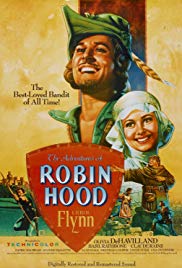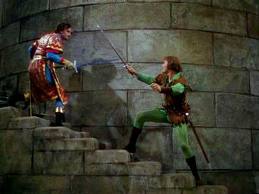THE ADVENTURES OF ROBIN HOOD
SUBJECTS — World/England & Middle Ages;
SOCIAL-EMOTIONAL LEARNING — Rebellion;
MORAL-ETHICAL EMPHASIS — Responsibility.
AGE: 8 – 13; No MPAA Rating;
Drama; 1938; minutes; Color. Available from Amazon.com.
There is NO AI content on this website. All content on TeachWithMovies.org has been written by human beings.

SUBJECTS — World/England & Middle Ages;
SOCIAL-EMOTIONAL LEARNING — Rebellion;
MORAL-ETHICAL EMPHASIS — Responsibility.
AGE: 8 – 13; No MPAA Rating;
Drama; 1938; minutes; Color. Available from Amazon.com.
TWM offers the following movie worksheets to keep students’ minds on the film and to focus their attention on the lessons to be learned from the movie.
Film Study Worksheet for a Work of Historical Fiction;
Film Study Worksheet for ELA Classes; and
Worksheet for Cinematic and Theatrical Elements and Their Effects.
Teachers can modify the movie worksheets to fit the needs of each class. See also TWM’s Historical Fiction in Film Cross-Curricular Homework Project and Movies as Literature Homework Project.
The Robin Hood legend, as shown in this movie, tells the story of the reconciliation between the Saxon people and the Normans who had conquered England in 1066. It was this reconciliation which created the English people as we know them today.
Selected Awards:
1938 Academy Awards: Best Film Editing, Best Art Direction, Best Original Score; 1938 Academy Award Nominations: Best Picture. “The Adventures of Robin Hood” is listed in the National Film Registry of the U.S. Library of Congress as a “culturally, historically or aesthetically significant” film.
Featured Actors:
Errol Flynn, Olivia De Havilland, Basil Rathbone, Alan Hale, Una O’Connor, Claude Rains, Patrick Knowles, Eugene Pallette, Herbert Mundin, Melville Cooper, Ian Hunter, Montagu Love.
Director:
Michael Curtiz and William Keighley.
MINOR. Robin’s arrows always seem to strike his opponents in the heart, and they die then and there without blood, which is exactly the way that children play at war, cops and robbers, etc. There is a little graphic violence when a Saxon is struck in the head. There is a potentially disturbing scene in which a little girl pleads for her father’s life.

Before watching the film, explain to your child how many cultures have created a story about a populist hero who is willing to risk a great deal in order to right various wrongs. Cultures also develop stories and myths to explain their origins. The story of Robin Hood is just such a myth. In 1066, almost a thousand years ago, Norman invaders from France conquered England. The people who lived in England at the time were primarily from two tribes, the Angles and the Saxons. After the conquest, the Normans became the privileged aristocrats; the Angles and Saxons were the farmers and the servants whose labor supported the expensive living style of the conquerors. Over several hundred years, the two groups began to intermarry and meld together to create the English people. Robin Hood is an Anglo-Saxon, from a former princely family of the conquered peoples. Maid Marion is a Norman. In the story, their marriage symbolizes the melding of the two groups, the Norman conquerors and the indigenous Angles and Saxons.
The Normans were descendants of Viking raider/settlers who controlled Normandy, a region in Northwest France. A Norman Army led by William the Conqueror invaded England in 1066. At that time England was ruled by Saxons, a tribe that had crossed into England from Germany. The Normans were fierce warriors and able administrators. William consolidated his hold over England by giving land to his barons in return for their agreement to provide knights for his army.
For several centuries there was conflict between the Normans and the Saxons before the two peoples merged into what is now referred to as the English people. The Robin Hood story is a myth of the integration process with the Saxon peasants looking to the Norman King Richard for protection against oppression by the Norman aristocracy. Note that the Norman aristocrat, Lady Marion, marries Robin, a Saxon.
Richard I, also called Richard Coeur de Lion, reigned from 1189 to 1199. All but six months of this time he was out of England. He participated in the Third Crusade and conquered Cyprus and Acre in 1191. He retook Jaffa for the Christians in 1192. On his way home, Richard I was captured by King Leopold of Austria and held for ransom until 1194. He returned to England for a short time and then fought in France until his death.
The legend of Robin Hood is perhaps the best example of the outlaw who robs the rich to give to the poor. Such individuals have been the themes of legends for hundreds of years.
1. See Discussion Questions for Use With any Film that is a Work of Fiction.
2. What was the importance of the marriage between Lady Marion, the Norman aristocrat, and Robin Hood, the Saxon aristocrat?
3. Why were the executioners wearing masks?
4. Is it moral to take from those who have more than enough to provide for themselves and their families (the rich and the middle class) and give to the poor? Governments do this and call it “redistribution of wealth.” Is this good public policy?
Suggested Response:
The consensus is that some redistribution of wealth imposed by the government is both necessary and just. According to most religious traditions, the rich should provide for the poor, but in reality, the wealthy don’t voluntarily give enough to meet the needs of the poor. In addition, the wealthy and middle classes benefit more than the poor from services provided by the government, such as defense, security at home, corporate welfare, tax shelters, the home mortgage interest deduction, etc. While most agree that some redistribution of wealth is good public policy, there is a vigorous debate over just how much wealth should be redistributed.
5. Why do you think that the Robin Hood legend endures?
6. Is stealing ever justified? If so, when?
1. Was it right for Robin Hood to rob the Normans who passed through Sherwood and give the money to the poor Saxon peasants? Should he have limited himself to certain Normans, such as those who were cooperating with Prince John and the Sheriff of Nottingham?
Discussion Questions Relating to Ethical Issues will facilitate the use of this film to teach ethical principles and critical viewing. Additional questions are set out below.
(Do what you are supposed to do; Persevere: keep on trying!; Always do your best; Use self-control; Be self-disciplined; Think before you act — consider the consequences; Be accountable for your choices)
1. Robin was the son of a Saxon nobleman. Did he have a responsibility to lead his people in rebellion against the unjust rule of the Norman regent?
A historical novel written for middle school and junior high readers concerning this era is The Ramsay Scallop, by Frances Temple. See also The Castle by Richard Platt (contains incredibly detailed cross sections of a medieval castle)
This Learning Guide was last updated on July 15, 2011.